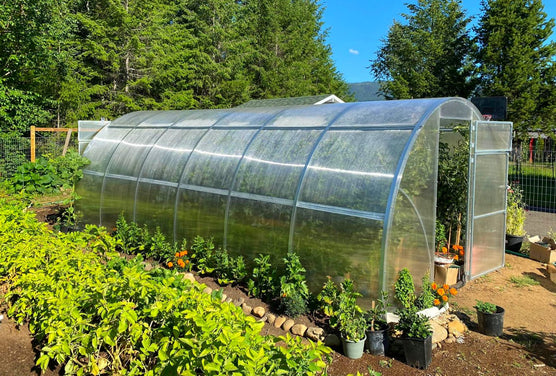Aesthetic Green Living: Monarch Decorative Greenhouse Utah Special Layouts
Wiki Article
The Future of Greenhouses: Advancements in Lasting Farming
Are you interested about the future of greenhouses and how they are changing lasting farming? From sophisticated environment control systems to vertical farming methods, water-efficient irrigation approaches, sustainable power combination, and clever information analytics, these improvements are changing the means we expand our food.Advanced Environment Control Systems
To achieve optimum expanding conditions, you can depend on the developments in greenhouses with advanced climate control systems. These systems have actually revolutionized the way we cultivate plants, giving a controlled atmosphere that contributes to plant development. With these innovative systems, you can currently control temperature level, moisture, light levels, and even carbon dioxide focus to develop the ideal conditions for your plants to flourish.Among the key features of these sophisticated climate control systems is their capacity to regulate temperature level. By utilizing sensors and automated controls, the greenhouse can readjust the temperature based upon the specific demands of the plants. This makes sure that they are never revealed to severe warmth or cold, which can be damaging to their development.
Moisture control is an additional important element of these systems. By maintaining the ideal humidity levels, you can prevent issues such as mold, mold, and illness from impacting your crops. These systems can also regulate the quantity of light that reaches the plants, guaranteeing that they obtain the optimal quantity for photosynthesis.
Furthermore, advanced climate control systems can even adjust carbon dioxide concentrations. By raising the levels of CO2 in the greenhouse, you can boost plant growth and performance. This is specifically advantageous in areas with low all-natural CO2 levels.
Upright Farming Methods
One vital vertical farming technique is making use of stacked expanding systems. Stacked expanding systems are generally made use of in urban locations where space is restricted.One preferred approach is referred to as upright hydroponics, where plants are grown in nutrient-rich water without dirt. This technique is highly efficient as it decreases water use by as much as 90% contrasted to conventional farming methods. Furthermore, considering that the plants are expanded indoors, they are shielded from bugs and illness, minimizing the demand for chemicals.
One more strategy is aeroponics, which includes suspending the plant roots in a mist or air environment. This approach permits for optimum nutrient absorption and oxygenation, resulting in faster development and higher returns. Aeroponics additionally uses less water than typical farming and can be carried out in vertical systems, making it a preferred choice for vertical farming.
Water-efficient Irrigation Approaches
Maximizing water preservation is vital when it comes to carrying out water-efficient irrigation techniques in sustainable farming. With global water deficiency becoming a pressing issue, it is critical to create ingenious methods that optimize water use in greenhouse procedures.One appealing technique is drip watering, which delivers water directly to the plant origins, reducing waste and evaporation. By making use of a network of tubes with small emitters, water is applied gradually and precisely, ensuring that plants get the necessary wetness without excess runoff.
An additional effective Full Article strategy is using dirt wetness sensing units. These gadgets gauge the moisture web content in the dirt and supply real-time information to farmers. By keeping track of the soil's wetness levels, farmers can precisely establish when and exactly how much water to apply, stopping over-irrigation.
Moreover, the implementation of rainwater harvesting systems is gaining appeal in greenhouse agriculture. Gathering rainwater from roofs and storing it in containers enables farmers to use this natural source for watering his explanation functions, lowering reliance on standard water resources.
Finally, the adoption of automated irrigation systems can significantly improve water performance. These systems use sensing units to discover soil dampness degrees and weather problems, readjusting watering timetables appropriately. By optimizing water use based on actual plant demands, these systems can lower water waste and advertise lasting farming techniques.
Renewable Resource Assimilation
Renewable energy integration in greenhouses offers numerous benefits, including decreased operating prices and lowered dependence on non-renewable power sources. The created power can after that be used to run numerous procedures within the greenhouse, such as lighting, home heating, and air flow systems. These turbines harness wind power and convert it into electricity, which can be utilized to supplement the power demands of the greenhouse.Smart Data Analytics and Automation
To enhance the efficiency of your greenhouse operations and optimize resource use, consider applying wise data analytics and automation. Smart data analytics entails gathering and evaluating data from different sensing units and tools within your greenhouse.
This can include automating the control of illumination, ventilation, irrigation systems, and nutrient shipment. By automating these procedures, you can make certain that your plants obtain the appropriate conditions and nutrients at the appropriate time, without the demand for consistent hand-operated treatment.
Furthermore, clever data analytics and automation can interact synergistically. The information accumulated by sensing units can be utilized to notify automated systems, enabling them to make real-time changes based on the current conditions. This integration of information analytics and automation can lead to extra accurate and reliable source allocation, eventually leading to greater yields and far better plant top quality.
Final Thought
In conclusion, the future of greenhouses in lasting agriculture looks promising. With advanced climate control systems, upright farming methods, water-efficient watering approaches, and renewable power integration, greenhouses are coming to be extra environmentally pleasant and reliable.
By optimizing water use based on real plant requirements, lawn mower with bag these systems can reduce water waste and advertise sustainable farming methods.

Report this wiki page